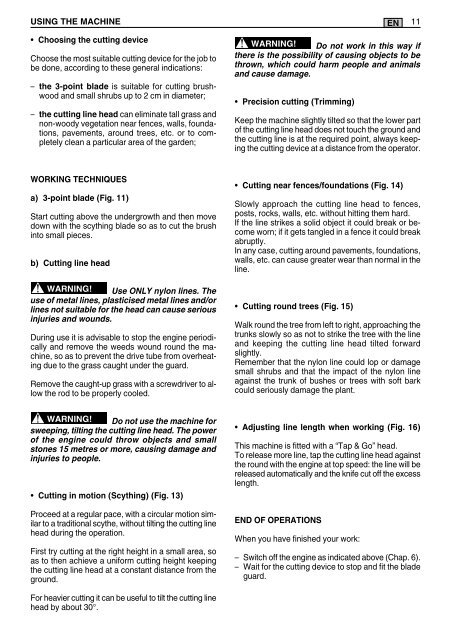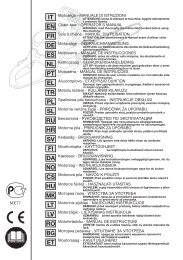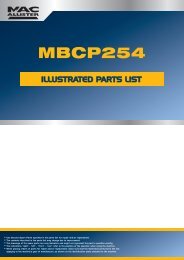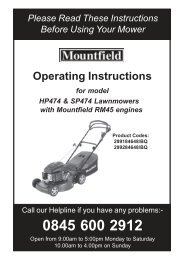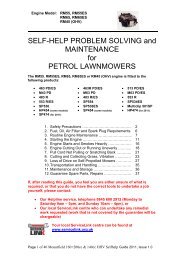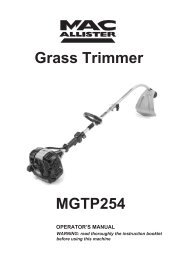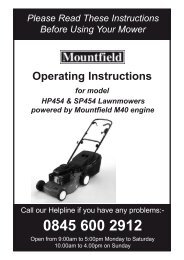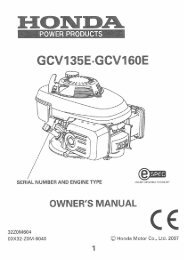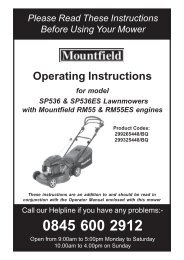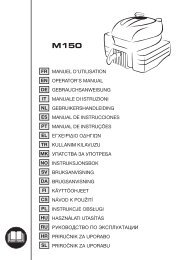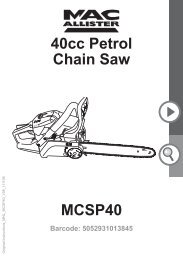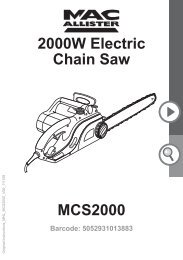MacAllister MBCP254 Brush Cutter - Service Link
MacAllister MBCP254 Brush Cutter - Service Link
MacAllister MBCP254 Brush Cutter - Service Link
Create successful ePaper yourself
Turn your PDF publications into a flip-book with our unique Google optimized e-Paper software.
USING THE MACHINE EN 11<br />
• Choosing the cutting device<br />
Choose the most suitable cutting device for the job to<br />
be done, according to these general indications:<br />
– the 3-point blade is suitable for cutting brushwood<br />
and small shrubs up to 2 cm in diameter;<br />
– the cutting line head can eliminate tall grass and<br />
non-woody vegetation near fences, walls, foundations,<br />
pavements, around trees, etc. or to completely<br />
clean a particular area of the garden;<br />
WARNING! Do not work in this way if<br />
there is the possibility of causing objects to be<br />
thrown, which could harm people and animals<br />
and cause damage.<br />
• Precision cutting (Trimming)<br />
Keep the machine slightly tilted so that the lower part<br />
of the cutting line head does not touch the ground and<br />
the cutting line is at the required point, always keeping<br />
the cutting device at a distance from the operator.<br />
WORKING TECHNIQUES<br />
a) 3-point blade (Fig. 11)<br />
Start cutting above the undergrowth and then move<br />
down with the scything blade so as to cut the brush<br />
into small pieces.<br />
b) Cutting line head<br />
WARNING! Use ONLY nylon lines. The<br />
use of metal lines, plasticised metal lines and/or<br />
lines not suitable for the head can cause serious<br />
injuries and wounds.<br />
During use it is advisable to stop the engine periodically<br />
and remove the weeds wound round the machine,<br />
so as to prevent the drive tube from overheating<br />
due to the grass caught under the guard.<br />
Remove the caught-up grass with a screwdriver to allow<br />
the rod to be properly cooled.<br />
• Cutting near fences/foundations (Fig. 14)<br />
Slowly approach the cutting line head to fences,<br />
posts, rocks, walls, etc. without hitting them hard.<br />
If the line strikes a solid object it could break or become<br />
worn; if it gets tangled in a fence it could break<br />
abruptly.<br />
In any case, cutting around pavements, foundations,<br />
walls, etc. can cause greater wear than normal in the<br />
line.<br />
• Cutting round trees (Fig. 15)<br />
Walk round the tree from left to right, approaching the<br />
trunks slowly so as not to strike the tree with the line<br />
and keeping the cutting line head tilted forward<br />
slightly.<br />
Remember that the nylon line could lop or damage<br />
small shrubs and that the impact of the nylon line<br />
against the trunk of bushes or trees with soft bark<br />
could seriously damage the plant.<br />
WARNING! Do not use the machine for<br />
sweeping, tilting the cutting line head. The power<br />
of the engine could throw objects and small<br />
stones 15 metres or more, causing damage and<br />
injuries to people.<br />
• Cutting in motion (Scything) (Fig. 13)<br />
Proceed at a regular pace, with a circular motion similar<br />
to a traditional scythe, without tilting the cutting line<br />
head during the operation.<br />
First try cutting at the right height in a small area, so<br />
as to then achieve a uniform cutting height keeping<br />
the cutting line head at a constant distance from the<br />
ground.<br />
• Adjusting line length when working (Fig. 16)<br />
This machine is fitted with a “Tap & Go” head.<br />
To release more line, tap the cutting line head against<br />
the round with the engine at top speed: the line will be<br />
released automatically and the knife cut off the excess<br />
length.<br />
END OF OPERATIONS<br />
When you have finished your work:<br />
– Switch off the engine as indicated above (Chap. 6).<br />
– Wait for the cutting device to stop and fit the blade<br />
guard.<br />
For heavier cutting it can be useful to tilt the cutting line<br />
head by about 30°.


